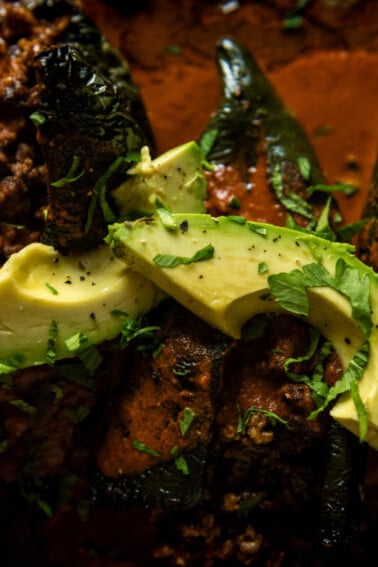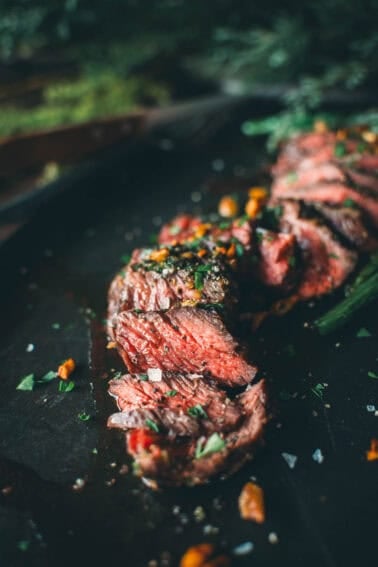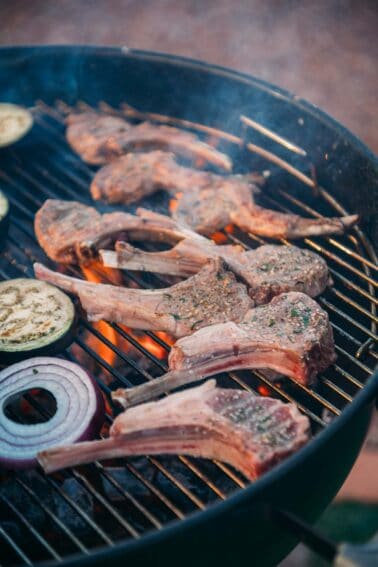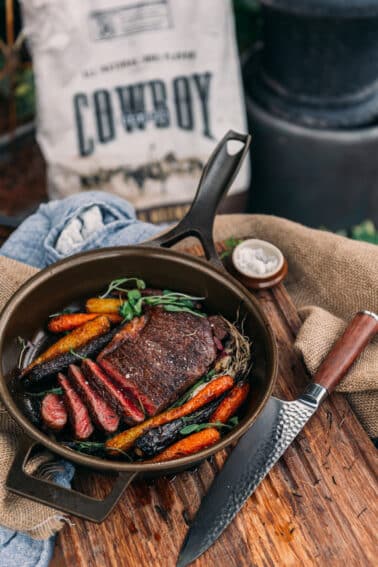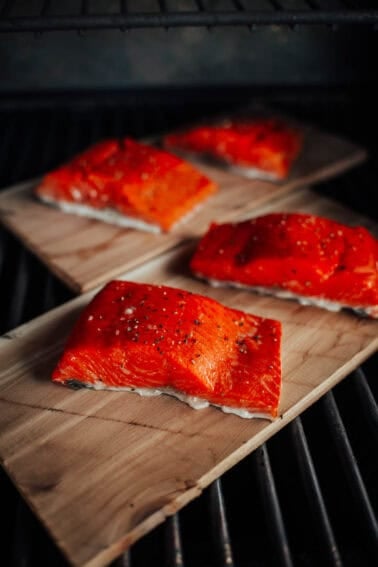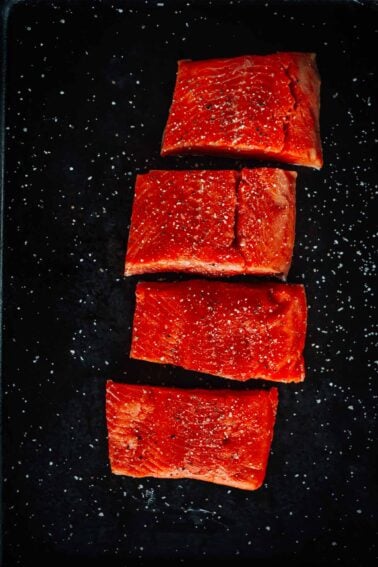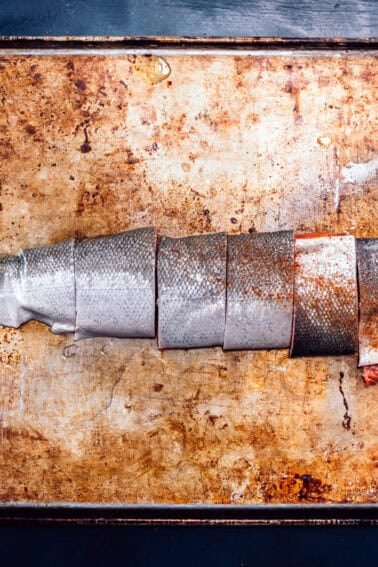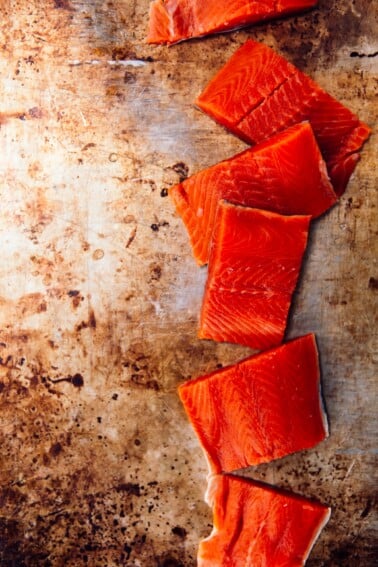Have you ever found yourself standing in the hardware store with a mountain of wood chips and chunks, wondering which one will transform that hunk of beef into a masterpiece? Congrats, you’re officially a griller, and, smoking wood can be a whole new world, filled with bold flavors like mesquite and subtle sweetness from fruit woods.
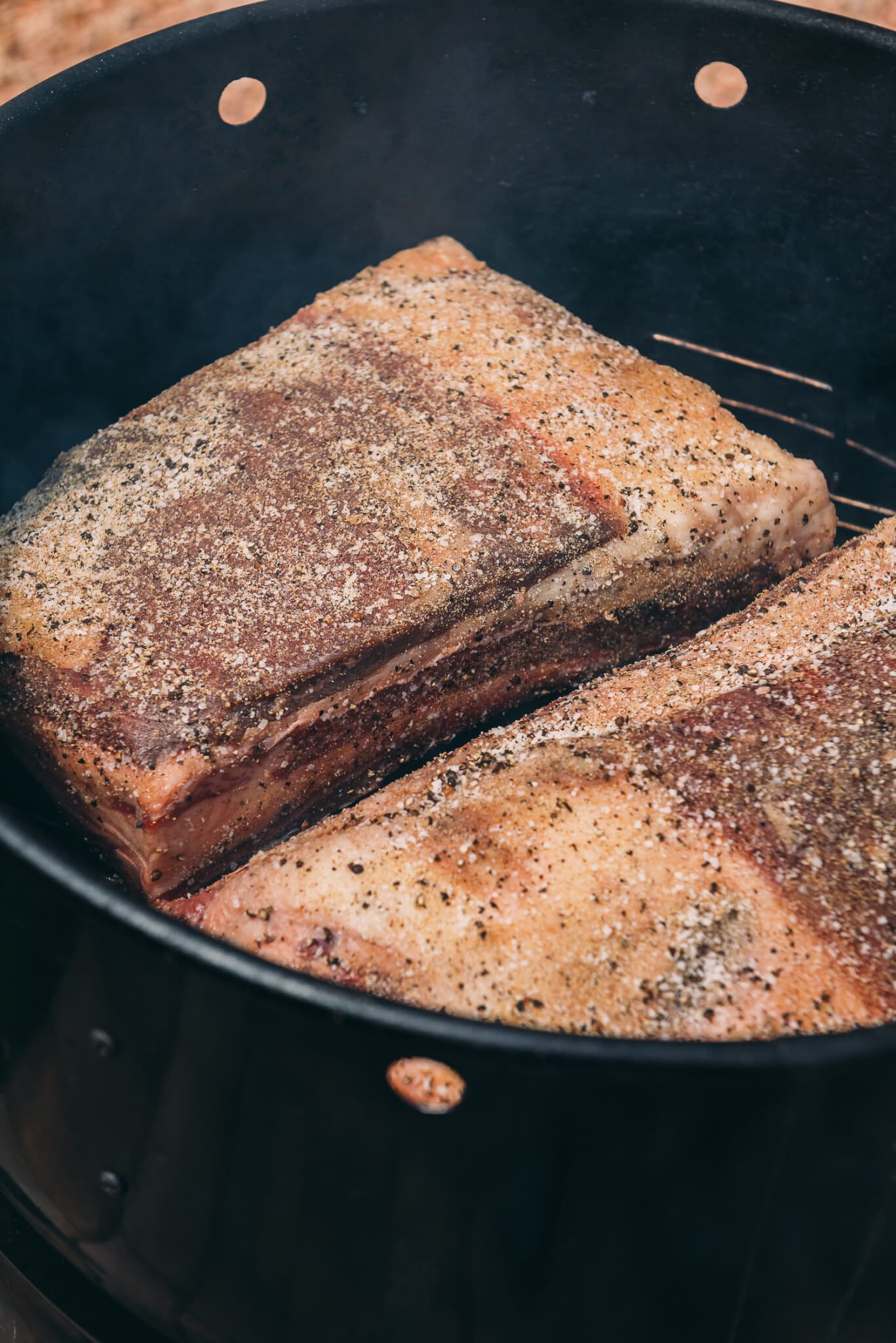
Table of Contents
- TL;DR SUMMARY
- Top 5 Best Woods for Smoking Beef
- OUR FAVORITE BRAND OF SMOKING WOOD:
- Our Favorite Smoked Beef Recipes
- Understanding Smoking Wood
- Tips and Techniques for Smoking Beef with Wood
- Preparing the Wood for Smoking
- Choosing the Right Amount of Wood
- Making the Perfect Wood Combinations
- Maintaining Consistent Temperature Throughout the Smoking Process
- Using a Charcoal Chimney
- More Helpful Grilling Tips
- faqs
But with so many different types of wood, how do you choose the right one for your next brisket or pot roast? Don’t worry. This guide is here to break it down for you. We’ll explore the most popular smoking woods, how they pair with different cuts of beef, and the smoky flavor profiles they bring to the table. By the end of this, you’ll be a seasoned grill master, ready to pick the perfect wood to elevate your beef recipes!
TL;DR SUMMARY
Don’t need to read a dissertation on meat? Here’s the 411 on the best smoking wood for beef.
- Beef’s big flavor can handle most woods. Oak and Hickory are our tried and true favorites.
- Make a combo of mesquite and hickory for long cooks and that authentic Texas taste.
- We always use Western Wood Chips and Chunks when smoking. We can buy them at grocery stores from coast to coast and love how consistently they burn.
- Make sure you’re using compressed wood pellets for pellet smokers and grills. We love B&B Post Oak or Hickory pellets. We’ also really love using the’re also really partial to the Jack Daniel’s charcoal pellets and adding wood chunks to the hot corners of our pellet smoker for that charcoal flavor.
- We use Cowoby Brand Lump Charcoal when grilling for the best flavor and because it has no added chemicals.
Top 5 Best Woods for Smoking Beef
Post Oak Wood
- Flavor Profile: Oak is a versatile champion, offering a mild to medium smoky flavor with a touch of earthiness, perfect for smoking recipes like reverse seared prime rib and smoked corned beef. It complements the natural beef flavor beautifully without overpowering it. Think of it as the “all-rounder” that pairs well with a variety of cuts, from briskets to steaks. Hands down, post oak is our go-to choice for 90% of the time.
- Burn Time: Oak falls in the medium burn time category, lasting for several hours. This makes it ideal for both long cooks like brisket and shorter smokes for roasts or thicker steaks.
- Heat Intensity: Oak offers a moderate heat intensity, providing a gentle smoke infusion without burning the meat.
Hickory Wood
- Flavor Profile: Hickory is a bold choice, packing a strong smoky punch with a hint of sweetness, perfect smoked beef short ribs. It’s a classic for red meats like beef, adding a robust, almost bacon-like flavor. However, use hickory sparingly – too much can overpower the meat. This is our second favorite go-to flavor.
- Burn Time: Hickory boasts a medium to long burn time, making it perfect for longer cooks like brisket or pork shoulder.
- Heat Intensity: Hickory burns hotter than some woods, so be mindful of your cooking temperature to avoid burning the meat.
Mesquite Wood
- Flavor Profile: Mesquite is the “smoky powerhouse,” delivering an intense, almost peppery smoke with a hint of bitterness. It’s a great choice for those who love a bold, smoky flavor, but proceed with caution – a little goes a long way with mesquite. We ONLY use mesquite sparingly and when cooking for people who we know LOVE barbecue. It’s one of the few flavors that not everyone likes and can actually turn people off of ‘grilled food.’
- Burn Time: Mesquite burns hot and fast, making it ideal for shorter cooks or heavier cuts that cook longer, like brisket. However, close monitoring is essential to avoid burning the meat, and consider mixing it with hickory or oak for larger cuts with longer cook times.
- Heat Intensity: Mesquite burns with the highest heat intensity on this list, so adjust your cooking temperature accordingly.
Pecan Wood
- Flavor Profile: Pecan offers a mild to medium smoky flavor with a touch of nuttiness and sweetness. It’s a good choice for those who want a subtle smokiness without overpowering the natural beef flavor. Pecan pairs well with lighter cuts like grilled veal chops or a filet mignon.
- Burn Time: Pecan falls into the medium burn time category, similar to oak. This makes it versatile for a range of cook times.
- Heat Intensity: Pecan burns with a moderate heat intensity, similar to oak, offering gentle smoke infusion without burning the meat.
Cherry Wood
- Flavor Profile: Cherry wood is a fruity favorite, known for its light, sweet smoke with a hint of fruitiness. It’s a perfect choice for smoked pastrami or burgers, adding a subtle sweetness that complements the meat. Avoid using cherry wood for long cooks, as the sweetness can become overpowering.
- Burn Time: Cherry wood has a short to medium burn time, making it ideal for shorter cooks or adding a burst of fruity smoke during longer cooks.
- Heat Intensity: Cherry wood burns with a low heat intensity, perfect for delicate cuts that don’t require high cooking temperatures.
OUR FAVORITE BRAND OF SMOKING WOOD:
Western Wood is our go-to brand for our Smoking Wood Chips and Chunks – you can find these in local grocery stores and hardware stores from coast to coast. It’s all kiln-dried and has burned consistently for us for over the 5 years we’ve been using it.
Our Favorite Smoked Beef Recipes
Beef Recipes
Ultimate Smoked Roast Beef
Beef Recipes
Enchilada Smoked Stuffed Poblano Peppers
Beef Recipes
Easy Smoked Pastrami
Beef Recipes
Smoked Beef Tenderloin Recipe
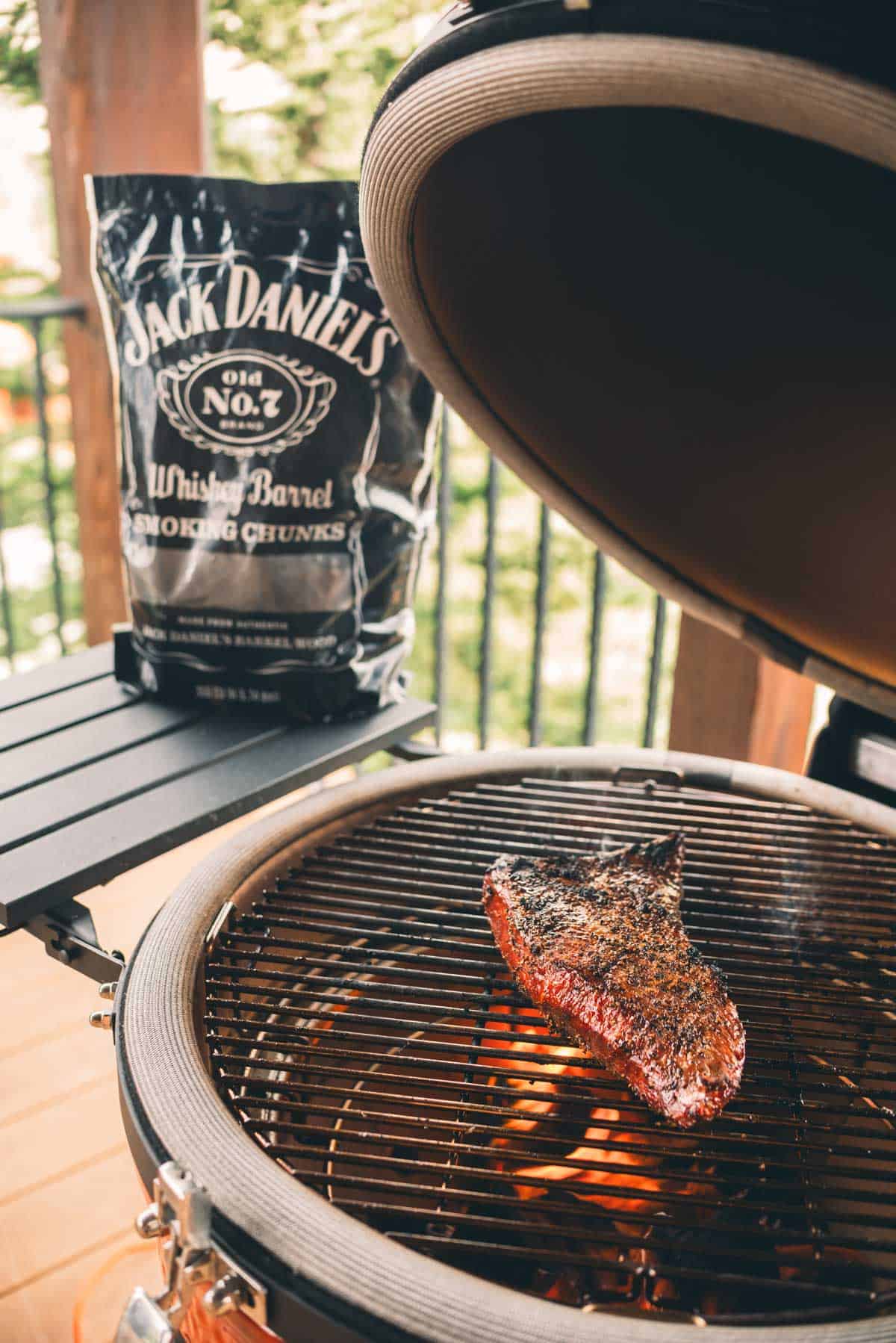
Understanding Smoking Wood
Smoking is a low and slow cooking process, and the flavor of the wood you use can significantly impact the flavor of your beef. The great thing about red meat is that it can pair with almost any wood flavor you throw at it. You want strong flavor? Go for hickory or mesquite. Want a more mild flavor? Try cherry or pecan. It’s all about what flavor profile you’re going for.
What is smoking wood?
Smoking wood isn’t just any firewood you toss onto the flames. These are special woods, typically hardwoods or fruitwoods, chosen for their unique flavor profiles and ability to produce clean, consistent smoke. As the wood smolders, it releases a fragrant smoke flavor that gently infuses your beef, adding depth and complexity that grilling alone can’t achieve.
Different types of smoking wood
Standing in the grilling aisle can get a little confusing these days (we know, we looked, and OMG so many choices)… When it comes to wood there, there are a few different forms it comes in:
- Wood Chunks for long cooks (like brisket or a whole steamship round).
- Wood Chips for shorter bursts of smoke (like smoked burgers).
- Logs for large smokers (but trickier to manage and ideally only for offset smokers or larger pits).
- Wood pellets are for pellet smokers. We love using Jack Daniel’s charcoal pellets in our Traeger grill.
Importance of selecting the right wood for beef
Choosing the right wood can make or break the flavor of your beef. For example, choosing a milder wood like peach wood may not give you that intense flavor you want versus mesquite or hickory. So, it’s important to understand the different flavors of wood and how they can affect the flavor of the meat.
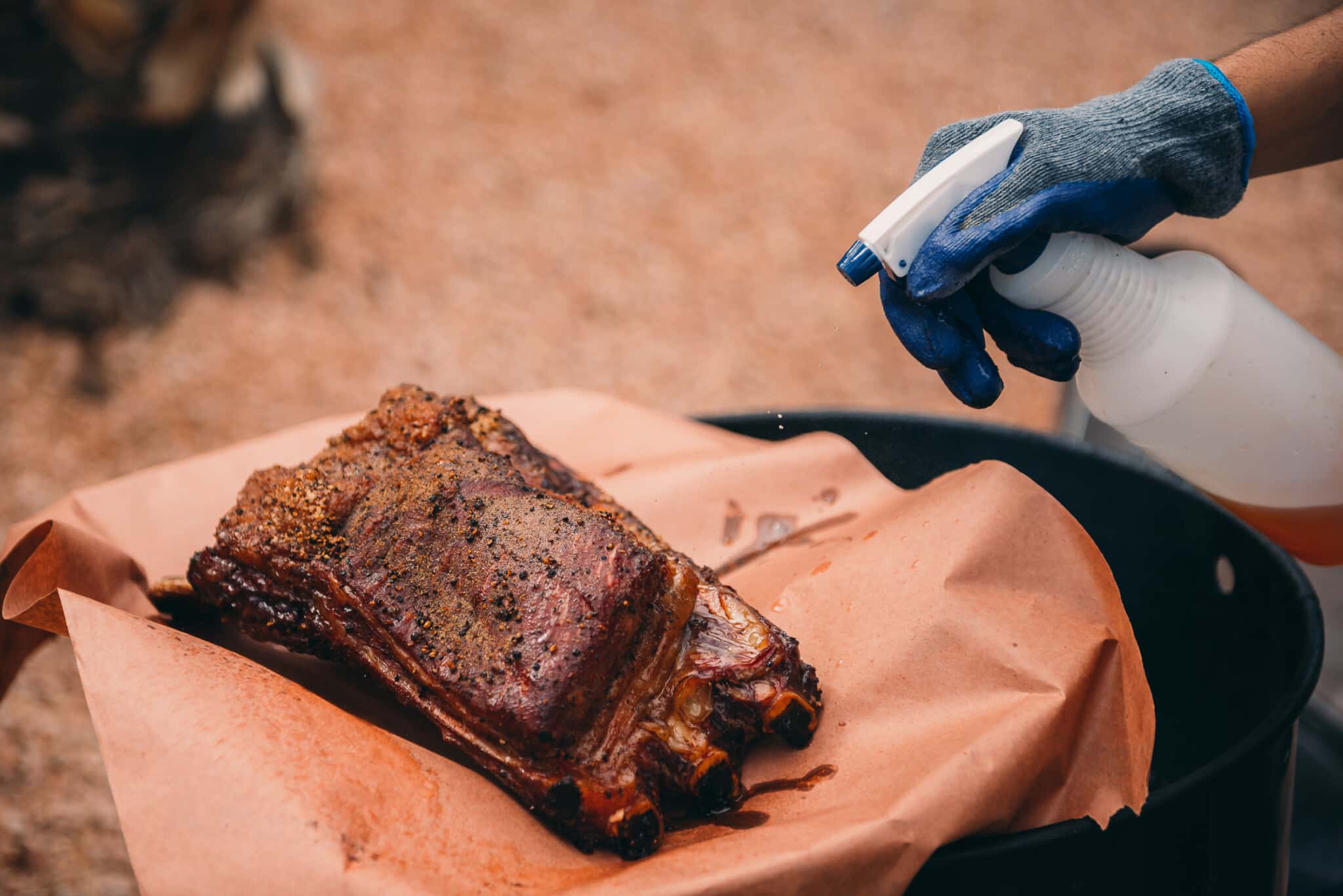
Tips and Techniques for Smoking Beef with Wood
Preparing the Wood for Smoking
For smoky perfection, skip soaking your wood chips. Soaked chips tend to steam instead of smoke, which dilutes the flavor we’re going for. If you’re not using store-bought kiln-dried wood, green wood is another no-no. It burns hotter and faster than seasoned wood and can release unpleasant chemicals that might affect the taste of your meat. Stick with dry, seasoned wood chips for the best results!
Choosing the Right Amount of Wood
The amount you use depends on a few factors: your smoker, the type of wood, and the length of your cook.
Here’s a general rule of thumb: start low and slow. For shorter smokes, begin with a small handful of wood chips or one to two wood chunks. You can always add more later if you feel the smoke flavor is too subtle. The key is to gradually build the smokiness to your preference. Remember, unlike spices, you can’t take smoke away once it’s infused into the meat. So, it’s always better to err on the side of caution and add more if needed.
Another thing to consider is the intensity of the wood you’ve chosen. Powerful woods like mesquite pack a serious smoky punch, so you’ll need much less compared to milder wood like oak.
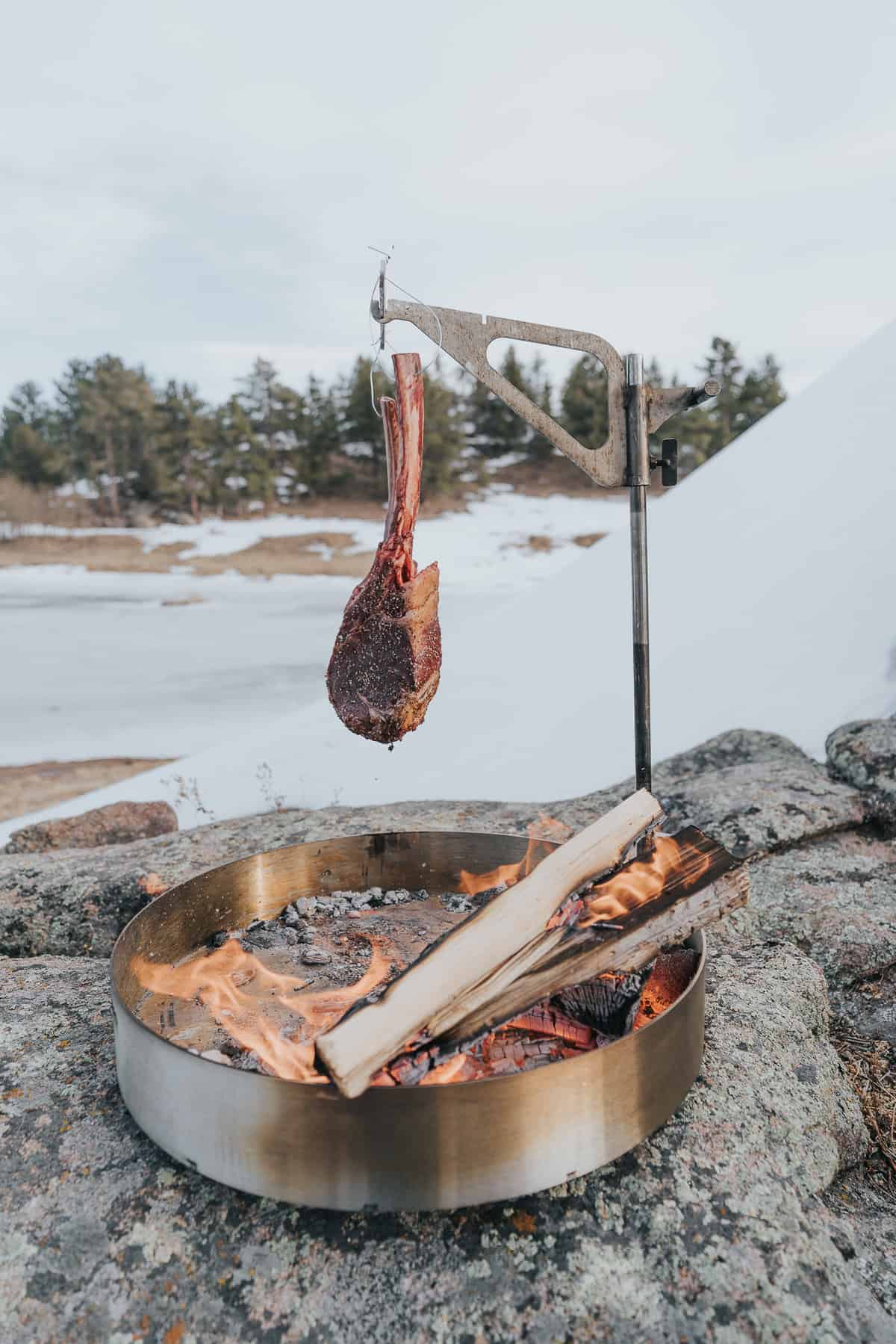
Making the Perfect Wood Combinations
- The Classic Combo: Hickory and Oak: This duo is a match made in barbecue heaven. Hickory brings its bold, smoky character, while oak adds a touch of earthiness and mellows the intensity a bit. It’s a perfect all-around pairing for brisket, pot roast, or steaks.
- Sweet and Smoky: Cherry and Oak: This combination is a great choice for lighter cuts of beef like tri-tip or skirt steak. The sweetness of cherry wood complements the natural flavor of the meat, while oak provides a subtle smokiness that keeps things balanced. If you don’t have cherry, try apple wood. It won’t give the same color, but it has a subtle sweet flavor that is perfect with oak.
- Texas Twang: Mesquite and Oak: This combination is a Texas barbecue staple. Mesquite brings the intense, almost peppery smoke that’s central to Texas-style barbecue, while oak tames the boldness a bit and adds some earthy complexity. Be sure to start low with mesquite, as its powerful flavor can easily overpower the beef.
Check out our full guide to smoking wood for more flavor pairings.
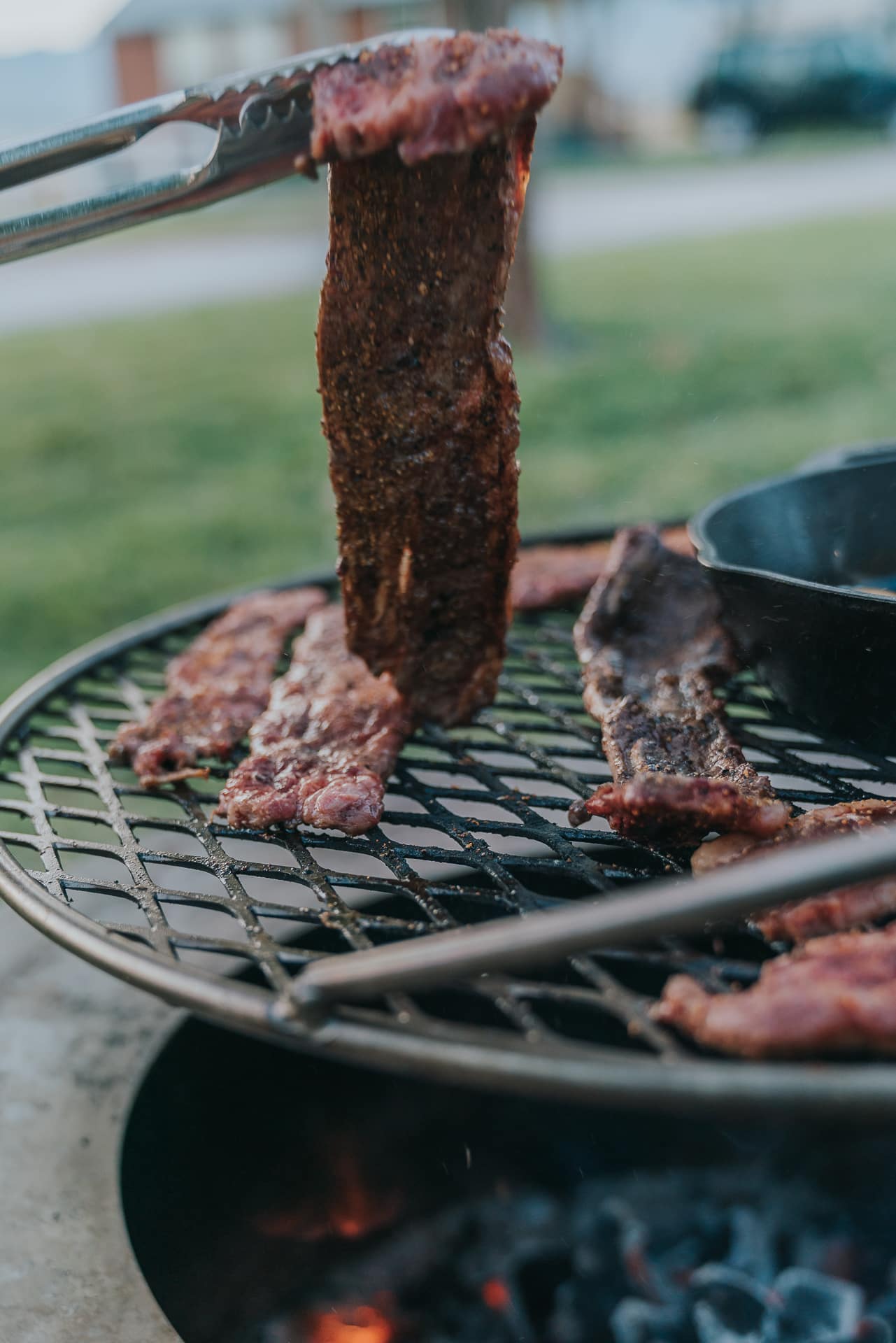
Maintaining Consistent Temperature Throughout the Smoking Process
Here are a few tips to make sure your smoker stays at the right temperature throughout the smoking process:
- Know your smoker: Do a practice run to understand its temperature swings.
- Venting is key: Adjust the dampers to control airflow and maintain heat.
- Fuel up strategically: Add wood chunks/chips regularly in small amounts to avoid spikes.
- Peek wisely: Monitor temperature with a meat thermometer, but avoid opening the smoker too often, or the smoke simply billows out. This also introduces more air, which can cause flare-ups and temperature fluxations. As Tuffy Stone says, “If you’re looking, you’re not cooking.“
- Wrap it up (optional): For longer cooks, consider wrapping the meat halfway through to retain moisture. At this point, the wood you use doesn’t matter.
- Practice makes perfect: The more you smoke, the better you’ll understand your smoker and temperature control.
Using a Charcoal Chimney
If smoking on a charcoal grill, use a charcoal chimney to get those coals nice and hot faster so you can start the smoking process. Once the coals are in the grill, add the wood and make sure it’s burning clean before you add your beef.
Alternatively, you can you use a charcoal chimney and wood chunks to build a fire. Just make sure that smoke is clean blue smoke before adding any food.
SAVE THIS GUIDE FOR LATER BY CLICKING THE ❤️ BUTTON AT THE TOP OF THE PAGE. DID YOU KNOW YOU CAN SAVE ALL OF YOUR FAVORITE RECIPES RIGHT TO YOUR OWN RECIPE INDEX ON GIRLCARNIVORE TO FIND THEM EASIER LATER ON?
More Helpful Grilling Tips
faqs
Absolutely! If you’re smoking on a gas grill, use a smoker box or a foil packet and fill it up with whatever wood chips you like.
You can smoke almost any type of beef! The most common beef cuts for smoking are brisket and ribs, but you can smoke smaller cuts like steaks, burgers, and even filet mignon. Smoking beef is a great way to add a smokey flavor to your beef.

